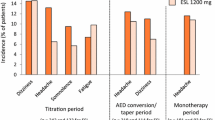Opinion statement
Effective treatment of seizures resulting from epilepsy relies on several basic principles, regardless of which drug or treatment is selected. Treatment starts with a confident diagnosis that the symptoms are, indeed, seizure. The seizure type should be classified as focal in onset or primary generalized, and there should be a relentless search for the etiology. Many antiepileptic drugs (AEDs) are available to treat partial-onset seizures. Given that the efficacy of AEDs is comparable, selection of the appropriate drug is mostly determined by whether any comorbidities are present, such as migraine, obesity, depression, or chronic pain. In the absence of comorbidities, it depends on the side effect profile, cost, and convenience. Most AEDs, with a few exceptions, must be increased to a maximum tolerated dose before a second drug should be added. Most patients can become seizure free or adequately controlled if continued interventions are considered at each encounter until patients are seizure free.

Similar content being viewed by others
References and Recommended Reading
Papers of particular interest, published recently, have been highlighted as: •• Of major importance
Hauser WA, Annegers JF, Rocca WA. Descriptive epidemiology of epilepsy: contributions of population-based studies from Rochester, Minnesota. Mayo Clin Proc. 1996;71:578–86.
Dreifuss FE, Bancaud J, Henriksen O, Rubio-Donnadieu F, Seino M, Penry JK. Proposal for the revised clinical and electroencephalographic classification of epileptic seizures. Epilepsia. 1981;22:489–501.
Commission of Classification and Terminology of the International League Against Epilepsy. Proposal for revised classification of epilepsies and epileptic syndromes. Epilepsia. 1989;30:389–99.
Berg AT, Berkovic SF, Brodie MJ, et al. Revised terminology and concepts for organization of seizures and epilepsies. Epilepsia. 2010;51:676–85.
Lee PR, Kossoff EH. Dietary treatments for epilepsy: management guidelines for the general practitioner. Epilepsy Behav. 2011;21(2):115–21.
Lefevre F, Aronson N. Ketogenic diet for the treatment of refractory epilepsy in children: A systematic review of efficacy. Pediatrics. 2000;105(4):E46.
Frucht M, Quigg M, Schwaner C, Fountain N. Distribution of seizure precipitants among epilepsy syndromes. Epilepsia. 2000;41:1534–9.
NIH Conference. “Curing Epilepsy: Hope for the Future.” Web address: http://www.ninds.nih.gov/news_and_events/conference_curing_epilepsy_summary.htm.
Fountain NB. Choosing Among Antiepileptic Drugs. Continuum: Lifelong Learning in Neurology. 2010;16(3):121–35.
French JA, Kanner AM, Bautista J, et al. Efficacy and tolerability of the new antiepileptic drugs I: Treatment of new onset epilepsy: Report of the Therapeutics and Technology Assessment Subcommittee and Quality Standards Subcommittee of the American Academy of Neurology and the American Epilepsy Society. Neurology. 2004;62:1252–60.
French JA, Kanner AM, Bautista J, et al. Efficacy and tolerability of the new antiepileptic drugs II: Treatment of refractory epilepsy: Report of the Therapeutics and Technology Assessment Subcommittee and Quality Standards Subcommittee of the American Academy of Neurology and the American Epilepsy Society. Neurology. 2004;62:1261–73.
Harden CL, Meador KJ, Pennell PB, et al. Practice Parameter update: Management issues for women with epilepsy—Focus on pregnancy (an evidence-based review): Teratogenesis and perinatal outcomes: Report of the Quality Standards Subcommittee and Therapeutics and Technology Assessment Subcommittee of the American Academy of Neurology and American Epilepsy Society. Neurology. 2009;73:133–41.
Fisher RS, Handforth A. Reassessment: Vagus nerve stimulation for epilepsy: Report of the Therapeutics and Technology Assessment Subcommittee of the American Academy of Neurology. Neurology. 1999;53:666–9.
Engel J, Wiebe Jr S, French J, et al. Practice parameter: Temporal lobe and localized neocortical resections for epilepsy: Report of the Quality Standards Subcommittee of the American Academy of Neurology, in Association with the American Epilepsy Society and the American Association of Neurological Surgeons. Neurology. 2003;60:538–47.
Kwan P, Brodie MJ. Early identification of refractory epilepsy. N Engl J Med. 2000;342(5):314–9.
Labiner DM, Bagic AI, Herman ST, Fountain NB, Walczak TS, Gumnit RJ, National Association of Epilepsy Centers. Essential services, personnel, and facilities in specialized epilepsy centers-Revised 2010 guidelines. Epilepsia. 2010;51:2322–33.
Fountain NB, Van Ness PC, Swain-Eng R, Tonn S, Bever Jr CT. For the American Academy of Neurology Epilepsy Measure Development Panel and the American Medical Association–Convened Physician Consortium for Performance Improvement Independent Measure Development Process. Quality improvement in neurology: AAN epilepsy quality measures: Report of the Quality Measurement and Reporting Subcommittee of the American Academy of Neurology. Neurology. 2011;76(1):94–9.
Wiebe S, Blume WT, Girvin JP, Eliasziw M. A randomized controlled trial of surgery for temporal lobe epilepsy. N Engl J Med. 2001;345:311–8.
Engel J Jr, et al. Early randomized surgery for epilepsy trial (ERSET). JAMA 2012;307(9):922–930.
Morrell MJ, RNS System in Epilepsy Study Group. Responsive cortical stimulation for the treatment of medically intractable partial epilepsy. Neurology. 2011;77(13):1295–304.
Fisher R, SANTE Study Group. Electrical Stimulation of the Anterior Nucleus of Thalamus for Treatment of Refractory Epilepsy. Epilepsia. 2010;51(5):899–908.
French JA, Wang S, Warnock B, Temkin N. Historical control monotherapy design in the treatment of epilepsy. Epilepsia. 2010;51:1936–43.
French JA, Temkin NR, Shneker BF, Hammer AE, Caldwell PT, Messenheimer JA. Lamotrigine XR conversion to monotherapy: first study using a historical control group. Neurotherapeutics. 2012;9(1):176–84.
Fountain NB. Manual of Antiepileptic Drug Therapy. West Islip: Professional Publications, Inc; 2010.
Disclosure
Dr. Shneker has received grant support from UCB, Pfizer, Eisai, GlaxoSmithKline, and Bial. Dr. Fountain has received grant support from the National Institutes of Health, UCB, Lundbeck, Medtronic, NeuroPace, Vertex Pharmaceuticals, SK Life Science, and Upsher-Smith Laboratories; has received royalties from Wolters Kluwer; and has had travel expenses covered/reimbursed by UCB.
Author information
Authors and Affiliations
Corresponding author
Rights and permissions
About this article
Cite this article
Shneker, B.F., Fountain, N.B. Antiepileptic Drug Selection for Partial-Onset Seizures. Curr Treat Options Neurol 14, 356–368 (2012). https://doi.org/10.1007/s11940-012-0186-5
Published:
Issue Date:
DOI: https://doi.org/10.1007/s11940-012-0186-5




